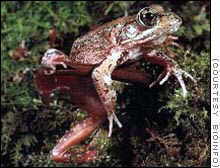|
Endometriosis |
||||||||||||
|
||||||||||||
|
||||||||||||
![]()
Herbicide blamed for sexual mutation in frogs
April 16, 2002 Posted: 10:55 AM EDT (1455 GMT)
WASHINGTON (AP) -- Male frogs exposed to even very low doses of a common weed killer can develop multiple sex organs -- sometimes both male and female -- researchers in California have discovered.

| |
| The California red-legged frog | |
"I was very much surprised," at the impact of atrazine on developing frogs, said Tyrone B. Hayes of the University of California at Berkeley.
Atrazine is the most commonly used weed killer in North America, he said, and can be found in rainwater, snow runoff and ground water.
"There is virtually no atrazine-free environment," Hayes said.
The Environmental Protection Agency permits up to 3 parts per billion of atrazine in drinking water.
But Hayes' team found it affected frogs at doses as small as 0.1 part per billion. As the amount of atrazine increased, as many as 20 percent of frogs exposed during their early development produced multiple sex organs or had both male and female organs. Many had small, feminized larynxes.
Hayes' research team concluded that the effect on the frogs results from atrazine causing cells to produce the enzyme aromatase, which is present in vertebrates and converts the male hormone testosterone to the female hormone estrogen.
The effects on frogs in Hayes' study occurred at exposure levels more than 600 times lower than the dose that has been seen to induce aromatase production in human cells.
Their research is reported in Tuesday's issue of Proceedings of the National Academy of Science.
Asked if atrazine might also be a threat to people at low levels, Hayes said he did not know, adding that, unlike frogs, "we're not in the water all the time."
Water fleas also affected
"I'm not saying it's safe for humans. I'm not saying its unsafe for humans. All I'm saying is it that it makes hermaphrodites of frogs," he said.
Stanley I. Dodson of the University of Wisconsin at Madison called the work "the most important paper in environmental toxicology in decades.
"It shows the effect of the most commonly used herbicide on amphibians in environmentally relevant concentrations," he said.
Asked if people should be worried, he also said: "We don't know."
"It's like a canary in the mine shaft sort of thing," Dodson said, referring to the former practice of miners of bringing canaries with them as warnings of dangerous gases. The birds are very sensitive to gases and would die before the concentration of the gas was enough to harm the miners.
Dodson said that in his research he had found that low exposures of atrazine changes the ratio of males to females among water fleas.
In addition to its effects on developing frogs, the Berkeley researchers found that male frogs exposed to atrazine after reaching maturity had a decrease in testosterone to levels equivalent to that found in females.
